The coronavirus spreads and the COVID-19 pandemic continues. While serious scientists and clinicians work on designing working therapies, their more creative colleagues pull out some unhinged ideas and run with it to easily excitable media journalists. Some start experimenting on people right away, some got a product to sell, or both.
For example, we all know that high doses of ionising radiation are very harmful, while lower doses are less harmful. Thus, for some scientists it stands to reason that low doses of radiation must be actually beneficial and why not trying that for COVID-19 therapy? Because their hunch is better than scientific evidence or even common sense, some doctors already began irradiating COVID-19 patients based on no science at all. Clinical trials with low dose radiation started in three hospitals in Spain (as reported by Sylvie Coyaud) and at the Winship Cancer Institute of Emory University in USA, as announced by the PI Mohammad Khan on Twitter (and then deleted). The Emory news eventually made it into Forbes, with the headline:
Researchers Explore Low Doses Of Radiation To Treat Severe Coronavirus Cases
Apparently, more US hospitals, and those in Italy, already put their patients aboard the magic ray tour. Emory explained the scientific background, or rather the absence thereof, in a press release:
“The investigators were inspired by the historical use of low dose chest radiation to treat pneumonia 100 years ago, citing research from the early 1900s that demonstrated improved survival as high as 90 percent in treating patients with pneumonia in the pre-antibiotic era.”
Indeed, the idea of a mysterious healing power of low dose radiation is quite old, it was briefly revived in 1986 when Chernobyl went pop, when IARC experts felt those hysterical Ukrainian and Belarussian peasants should actually be grateful for having their health boosted by a healthy dose of gamma rays (read more about their ideas in this book). Hence, who says a crazy theory can’t be revived again, for another disaster?
Another interesting approach to designing COVID-19 therapies is to ask who dies most and then drunkenly fumble your way from there. Around 70% of COVID-19 dead are male, as it happens. This is why on 27 April the New York Times asked:
Can Estrogen and Other Sex Hormones Help Men Survive Covid-19?
The medical logic here is simple. If men are turned into quasi-females with some female hormones, they sure will be protected from the ravages of the coronavirus. It stands to reason, and as NYT announced:
“Last week, doctors on Long Island in New York started treating Covid-19 patients with estrogen in an effort to increase their immune systems, and next week, physicians in Los Angeles will start treating male patients with another hormone that is predominantly found in women, progesterone, which has anti-inflammatory properties and can potentially prevent harmful overreactions of the immune system.”
The clinical trial at Stony Brook in NY has 110 patients and the one at Cedars-Sinai in Los Angeles has 40, in case you thought it all was meant as a joke. Funnily, German doctors associated low testosterone in men with higher COVID-19 mortality, so there. Maybe I should mention that other genius doctors at Cedars-Sinai invented a UV light rod which can be inserted either in the anus or the trachea, to cure bacterial infections, or the coronavirus. Keen to try? Read here.
Nothing is too stupid or embarrassing, because these are COVID-19 times where some nations hit worst have criminal clowns as their leaders. Of course, the biggest COVID-19 risk group are not just men, but old men. Which brings us to the main topic of this article, of the never-ageing anti-aging quackery, repurposed as COVID-19 therapy. It was to be expected, given the insane amount of money anti-aging supplements earn or burn (depending on your perspective).
On 3 May 2020, the British information authority The Daily Mail reported a scientific breakthrough in the fight against the COVID-19 pandemic:
Elderly coronavirus patients should be given anti-ageing drugs to make their immune systems ‘younger’ so they can fight the virus faster, scientists claim
The article referred to a preprint posted by “Harvard scientists”, and its lead author, the Harvard professor David Sinclair is quoted:
“NAD+ is the closest we’ve gotten to a fountain of youth. It’s one of the most important molecules for life to exist, and without it, you’re dead in 30 seconds.“
The idea is genius. Who dies most often from COVID-19? Old people. What to do to escape COVID-19 danger then? Stop being old. How? Buy Professor Sinclair’s anti-aging NAD+ supplements.
If you are still unconvinced: the miraculous anti-aging effect of NAD+ supplementations has been verified by the facts that it appeared in top journals like Cell, the elite Boston of affiliations of the scientists behind it (Sinclair is in Harvard, his postdoctoral mentor Leonard Guarente is at MIT), the massive money invested and made, and the fact that journalistic coverage says it works.

Both Sinclair and Guarente are business heavyweight who made millions. The latter is founder of the anti-aging start-up Elysium, which sells NAD+ supplements patented by Sinclair. But their previous financial masterpiece was the company Sirtis, which was set up by Sinclair to market the magic substance resveratrol as anti-aging supplement. Resveratrol is normally a natural plant substance very popular in with scientists and media, because it is present as trace element in (among many other things) red wine, which makes for excellent marketing.
Resveratrol in a pill would that make you young and on top cure all possible diseases like diabetes and even cancer) via the (never confirmed, but often postulated) process of activation of SIRT enzymes, or sirtuins. These are NAD-dependent deacetylases of various proteins involved in cancer and sensescence, which led Sinclair and Guarente to another commercial idea, namely that of NAD+ as SIRT1 activator, marketable as dietary supplement.
Sinclair sold Sirtis to the pharma giant GlaxoSmithKline (GSK) for $700 million, which made him and Guarente very, very rich. GSK however soon regretted the purchase and abandoned the SIRT research. The snag was hit long before any pharmacological efficiency could be tested in vivo, namely with achieving any significant bio-availability of resveratrol. It is not clear if the lead product SRT501 ever delivered anything. On top of that, one of Sirtris’ original founders Christoph Westphal had to resign when GSK found out he was selling same SRT501 supplements via his own private company. Sirtis then tried its luck with alternative supplements (SRT2104 and SRT1720) but that led nowhere either (there were rumours of toxicity), so GSK pulled the plug completely.
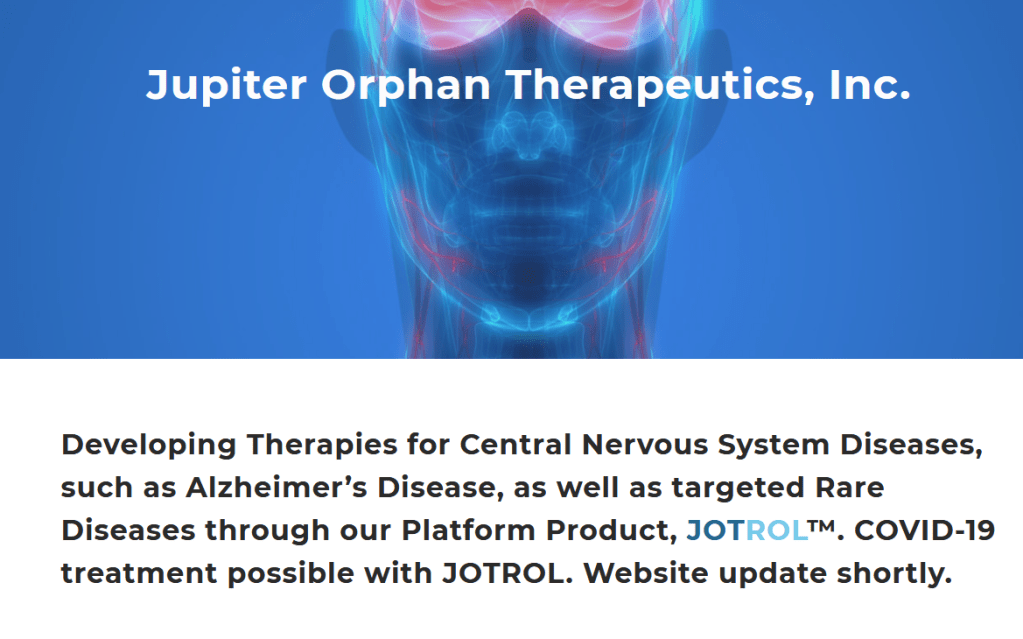
Sinclair of course didn’t give up, among many other businesses he has shares in and advises is the start-up Jupiter Orphan Therapeutics. Which of course sells resveratrol supplements, which of course is now advertised as the cure against COVID-19.
To give you a bit of perspective: one of Sinclair’s harshest critics is Charles Brenner, professor at University of Iowa. Now Brenner just happens to be chief science advisor of the company ChromaDex, which incidentally just happens to sell a different kind of NAD+ supplements, based on one of his patents. That company just happened to have sued Guarente’s (and Sinclair’s) Elysium over whose NAD+ product is the right one, with Brenner on the frontpage of media reporting (ChromaDex won the lawsuit, I was informed). And guess what: Also Brenner now says NAD+ supplements could prevent you from catching COVID-19, because obviously this is how anti-aging research community ticks.
This very encouraging press release appeared on 20 April:
“ChromaDex Commits to COVID-19 Research[…]
Preclinical research from Dr. Charles Brenner and a team of leading scientists from three US universities concludes that key steps in coronavirus infection and innate immunity involve a tug-of-war with cellular NAD […]
“As a science-based company with a unique NAD boosting molecule and knowing that our cells’ NAD is depleted by viral infections, we take our responsibility seriously and will leverage our science resources to expedite continuing research on the potential impact of Niagen,” says Rob Fried, ChromaDex CEO.”
It is not irrelevant to mention here that Guarente once stood in the middle of a huge research fraud scandal and came out unscathed. His then-postdoc Gizem Donmez falsified a number of high profile papers which won her a professorship at the Tufts University and a very prestigious award from the Ellison Foundation (incidentally, board member then was Guarente). When scientist and whistleblower Paul Brookes exposed Donmez’ Photoshop activities, she hired a star lawyer (who won the David Baltimore case) to threaten Brookes. At the journal Cell, then led by the fraud-fetishist Emilie Marcus, nobody initially gave a toss, the editor tasked with telling Brookes to get lost was Sri Devi Narasimhan, Guarente’s scientific “grandchild”.
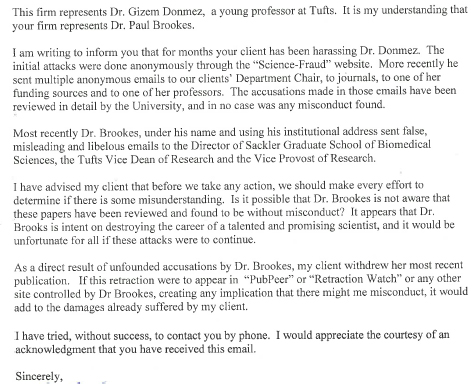
Eventually, the fraud proved too much to cover up, all papers were retracted, and Donmez was sacked by Tufts. She returned to Turkey, as faculty member of the Adnan Menderes University. It seems MIT decreed Guarente officially had absolutely nothing at all to do with his own last author’s papers retracted for fraud. Will MIT decide same way in the case of another star scientist now?
Now that we spoke of photoshopping research results, we can return to the discussion of NAD+ discoveries by Guarente’s mentee and business partner, Sinclair. Who is about to save everyone who buys their NAD+ supplements from COVID-19.
Sinclair papers
The following rather recent publication in Cell reported how Sinclair’s proprietary NAD+ booster product nicotinamide mononucleotide, marketed commercially to you, the consumer, as NMN pills via authoritative journalism sources, rejuvenates mice.
A Das , GX. Huang , MS. Bonkowski , A Longchamp , C Li , MB. Schultz , LJ Kim , B Osborne , S Joshi , Y Lu , JH Treviño-Villarreal , MJ Kang , T Hung , Brendan Lee , EO. Williams , M Igarashi , JR. Mitchell , LE. Wu , N Turner , Zt Arany , L Guarente , David A. Sinclair Impairment of an Endothelial NAD+-H2S Signaling Network Is a Reversible Cause of Vascular Aging Cell (2018) doi: 10.1016/j.cell.2018.02.008

Somehow the loading control from Figure 2 reappeared in Figure S2, only with its labelling flipped and showing a very different tissue. There was more. Somehow samples from different parts of rejuvenated mouse legs became strikingly identical!
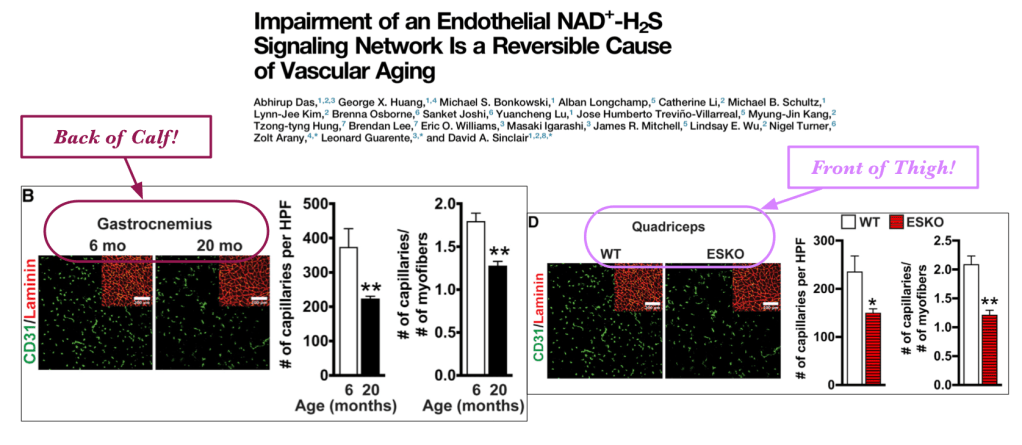
Sinclair himself immediately replied on PubPeer in September 2018:
“The authors identified the error immediately after publication and sent a correction to the journal on April 9th, 2018, where it, and the original blots, were vetted. Below is the corrected figure and statement we sent in. We are grateful for the opportunity to rectify the error and apologize for any confusion.”
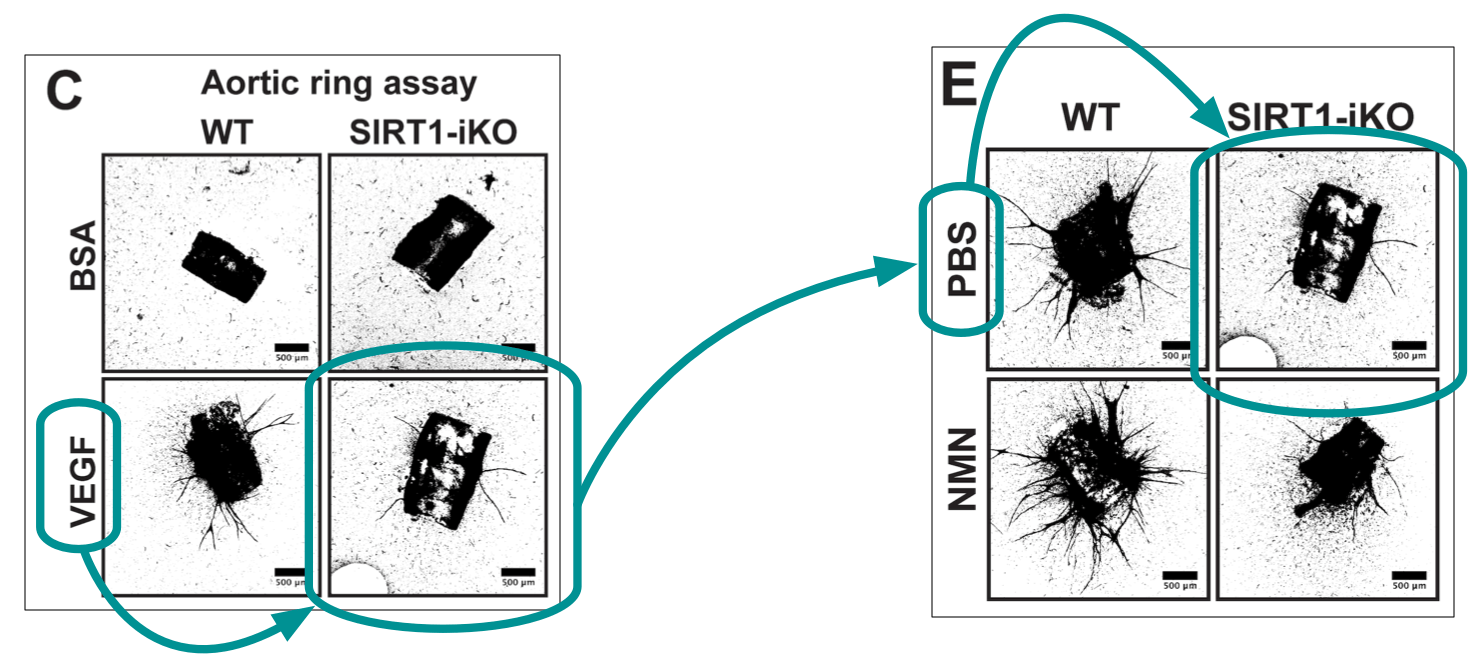
Cell issued a correction for these figures in February 2019 and closed the case. Another issue, also flagged in September 2018 was disregarded completely, presumably because Professor Sinclair did not agree. Maybe the growth factor VEGF went off and was hence declared to have no effect, equivalent to the empty PBS buffer?
The anti-aging effect of Sinclair’s patented NAD+ pills was certified in a previous Cell paper:
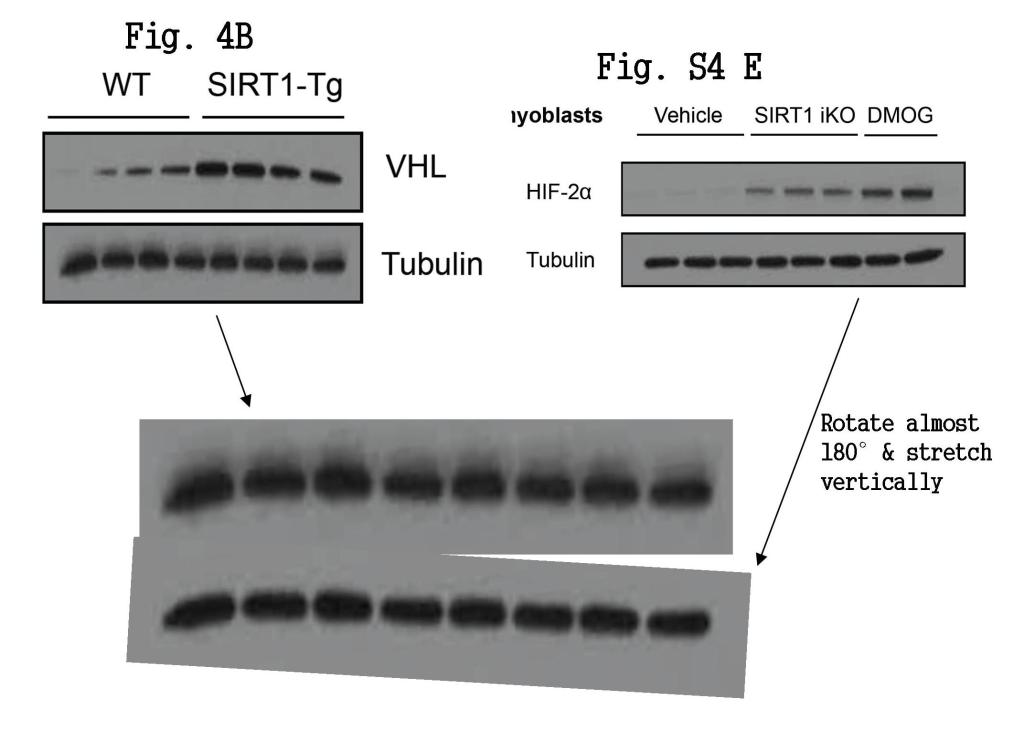
AP. Gomes , NL. Price , AJ.Y. Ling , JJ. Moslehi , MK. Montgomery , L Rajman , JP. White , JS. Teodoro , CD. Wrann , BP. Hubbard , EM. Mercken , CM. Palmeira , R De Cabo , AP. Rolo , N Turner , EL. Bell , DA. Sinclair Declining NAD(+) induces a pseudohypoxic state disrupting nuclear-mitochondrial communication during aging Cell (2013) doi: 10.1016/j.cell.2013.11.037
That Cell paper from 2013 contains some bizarre compression artefacts which might warrant further scrutiny. Except of course this is Cell, so it won’t. Neither will anyone bother about an even earlier Cell paper by Sinclair:
H Yang , T Yang , JA. Baur , E Perez , T Matsui , JJ. Carmona , DW. Lamming , NC. Souza-Pinto , VA. Bohr , A Rosenzweig , R De Cabo , AA. Sauve , DA. Sinclair Nutrient-Sensitive Mitochondrial NAD+ Levels Dictate Cell Survival Cell (2007) doi: 10.1016/j.cell.2007.07.035

What happened here? Lanes 3 are mitochondria extracts, prepared with two different mitochondrial extraction protocols. These mitochondria extracts are, as opposed to total cell lysates (lanes 1) and cytosolic extracts (lanes 2), not supposed to contain any Hsp90 protein. Because they probably did anyway, the “mito” lanes of these two gels were edited out and replaced with a blank patch.

Same Figure 5E had a related problem with cell fractionation in Photoshop. Cytosolic extracts in the lane 2 are not supposed to contain any Lamin A/C which is a nuclear protein. But apparently they did anyway, and the advanced technological fix to this cell fragmentation protocol was to paste a blank patch to cover up the problematic protein signal (image on the right).
Ta-da, this is how Harvard scientists produce results for Cell.
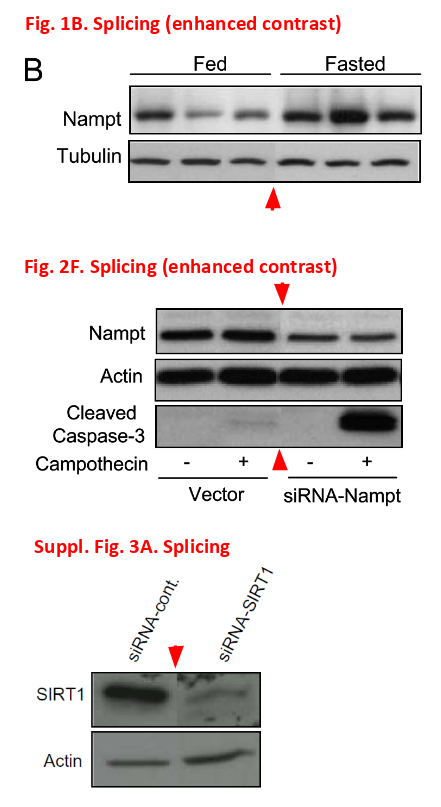
Finally, there was lots of gel splicing which was apparently permitted back then if sufficiently well hidden, and a very plump image duplication, because nobody ever reads or cares about supplementary material.
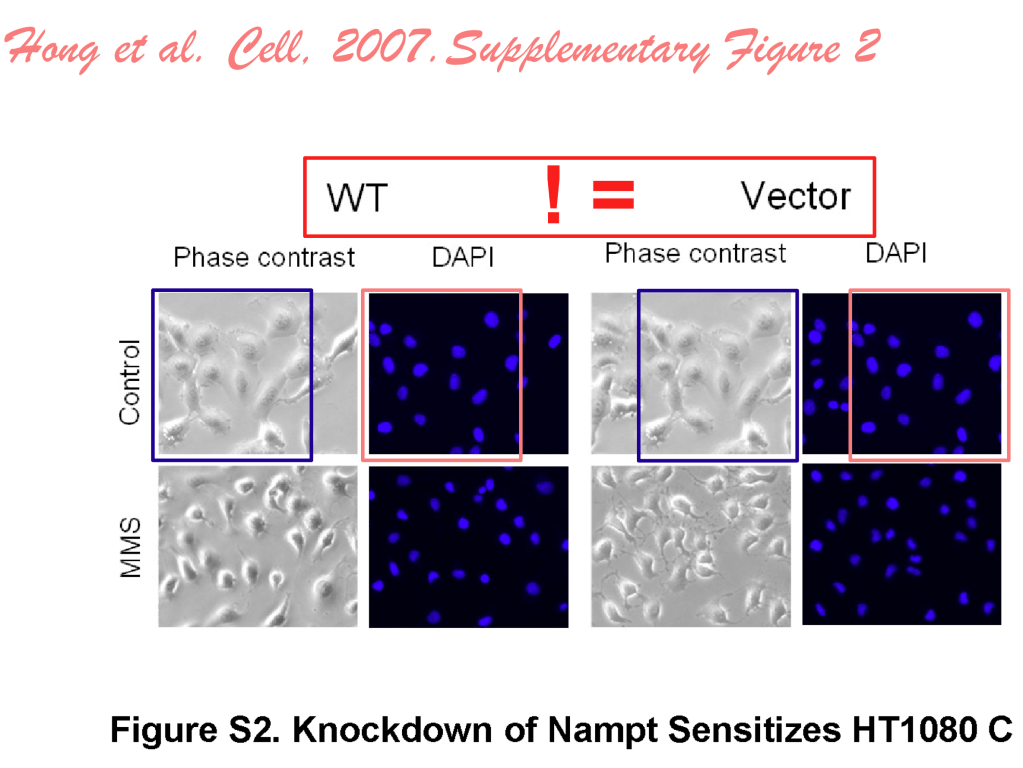
In 2013, the Journal of Biological Chemistry corrected a Sinclair paper about NAD+ anti-aging effect, because “the same images of yeast colonies were inadvertently shown for two different wild type controls in Fig. 2A“. Maybe the journal should have another look, there is even more deserving a retraction. To be fair, Sinclair did place an Easter egg by openly anouncing already in the paper’s title about “manipulation”.
RM. Anderson , KJ. Bitterman , JG. Wood , O Medvedik , H Cohen , SS. Lin , JK. Manchester , JI. Gordon , DA. Sinclair Manipulation of a nuclear NAD+ salvage pathway delays aging without altering steady-state NAD+ levels Journal of Biological Chemistry (2002) doi: 10.1074/jbc.m111773200
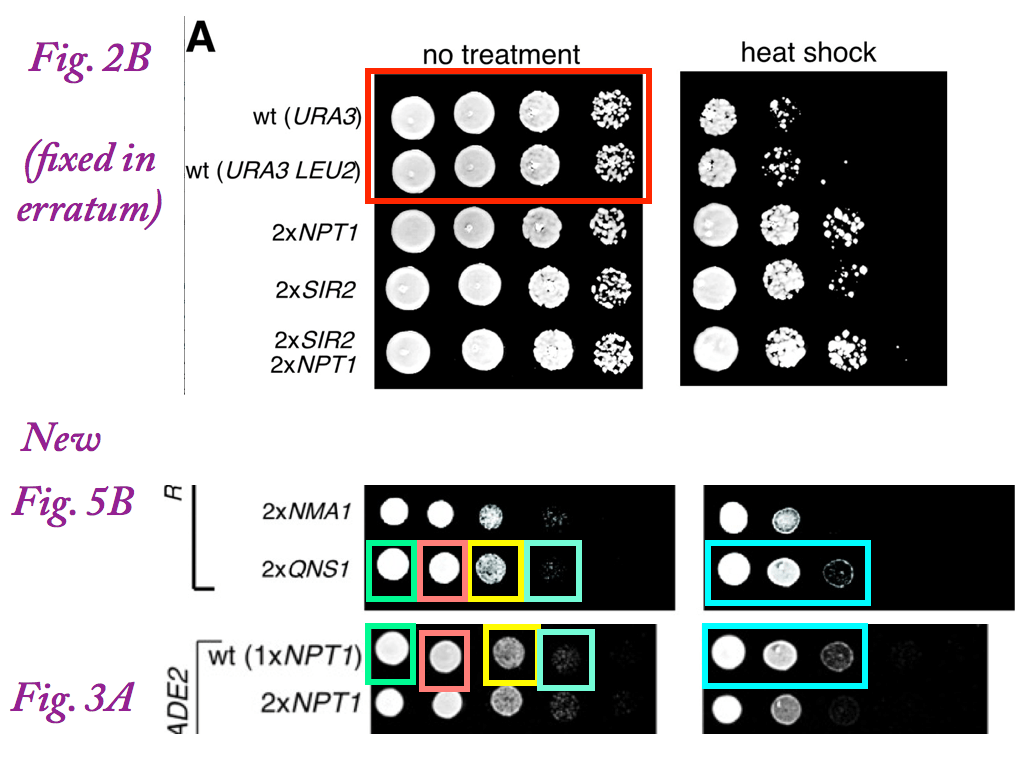
This additional evidence of intentional data fakery in Figures 5B and 3A is 6 years old. Pity Professor Sinclair is too busy getting rich with anti-aging supplements to fix his papers, maybe JBC can help him?
Around 20 years ago, Sinclair was busy extending the lives of yeast, like here in Science:

RM Anderson , M Latorre-Esteves , AR Neves , S Lavu , O Medvedik , C Taylor , KT Howitz , H Santos , DA Sinclair Yeast life-span extension by calorie restriction is independent of NAD fluctuation Science (2003) doi: 10.1126/science.1088697
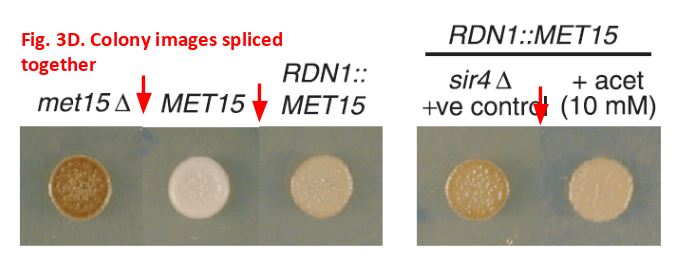
You might notice that also here, the yeast colony images in Figure 1 were copied with brightness adjusted, so they don’t immediately appear identical. In Figure 3D, yeast colonies cannot be compared with each other because the images were spliced. The paper was never corrected. One does not correct or retract papers from Harvard. Both Cell and Science know it.
There are more vintage Sinclair shenanigans, protocolled by Paul Brookes. The file is available here:
Sinclair is one of the Editors-in-Chief of the journal Aging, next to Mikhail Blagosklonny (who also runs Oncotarget and whose lawyer threatened me to tweet only good thing about this journal). If you wonder how diligent the peer review at Aging is: one of Sinclair’s own papers was submitted and accepted literally over Christmas.
Which brings us to the next anti-aging expert and magic COVID-19 healer, Michael Lisanti, editorial board member of Aging, initially recruited from US to UK as prestigious Muriel Edith Rickman Chair in Breast Oncology at the University of Manchester, then transferred to the neighbouring University of Salford.
The magazine Heath Europe titled on 8 April 2020:
Could azithromycin prevent NHS workers from developing COVID-19?
Now don’t get overexcited, this is not about Didier Raoult (the miracle doctor from Marseille who designed a chloroquine + azithromycine therapy against COVID-19 (read more here, here. and here). But close.
The article covers the genius idea of Michael Lisanti which is closely related to that of Sinclair’s: rejuvenation to escape COVID-19. At least Lisanti does not offer his own supplements for sale (he was of course more than happy to peddle matcha tea as a cancer cure in return for some cash from OMGtea). What Lisanti usually does, is to propose same boring old drugs like antibiotics or Vitamin C as cancer cures or “senolytics”, meaning Lisanti believes these can dissolve senescent (i.e. aged) cells and rejuvenate you back to your healthy, disease-resistant youth. Coronavirus can’t harm you because you purged all your senescent cells, easy as that.
In a March 30 paper published by Lisanti in his own journal Aging, he declares which drugs exactly:
“two proposed therapeutics for the treatment of COVID-19 infection are Azithromycin and Quercetin, both drugs with significant senolytic activity. Also, Chloroquine-related compounds inhibit the induction of the well-known senescence marker, Beta-galactosidase. Other anti-aging drugs should also be considered, such as Rapamycin and Doxycycline, as they behave as inhibitors of protein synthesis, blocking both SASP and viral replication. Therefore, we wish to speculate that the fight against COVID-19 disease should involve testing the hypothesis that senolytics and other anti-aging drugs may have a prominent role in preventing the transmission of the virus, as well as aid in its treatment.“
No word here about “senolytic” effect of the doxycycline (which is an antibiotic, i.e. it works against bacteria, but not viruses), but Lisanti insisted it inhibits the replication of Dengue virus in vitro, as one paper has shown.
In parallel, Lisanti advocated in The BMJ:
Doxycycline for COVID-19 Prophylaxis in NHS Frontline Workers
Lisanti wrote there:
“I would like to propose that frontline NHS healthcare workers take the antibiotic Doxycycline (1) prophylactically to prevent COVID-19 infections in hospital and GP settings nationwide. For example, they could take 100-mg of Doxycycline per day.“
Lisanti is a funny guy actually. He is very good in hogging media attention with crazy cancer cures or anti-aging solutions. In Daily Mail, he paraded in 2015 his then 8 year old daughter as a discoverer of a cancer cure: the very same antibiotic doxycycline.
“Professor Lisanti and his wife, Federica Sotgia, were discussing their research over dinner one evening when they decided to ask their daughter for her opinion. The professor said: ‘She has heard us talk about cancer a lot and we thought it would be fun to ask her what she thought about cancer therapy.
‘We asked her how she would cure cancer and she said “Mum and Dad, I would just use an antibiotic, like when I have a sore throat.’
Rather than completely dismissing the answer, the professor did a DIY experiment, rubbing an antibiotic cream on a small growth on his face. When the growth disappeared, he did some reading that confirmed that Camilla may have been on to something.”
Actually, no, this is not funny. Lisanti and his wife Federica Sotgia (who used to be Lisanti’s postdoc back at his previous lab at the Albert Einstein College of Medicine in New York) immediately run at the University fo Salford a clinical trial with real cancer patients, which they declared a success. In a press release.
You probably know I am going to discuss Lisanti’s papers now, right? But before that, you shoudl know it was all investigated after the pseudonymous sleuth Clare Francis reported him some years ago. Lisanti is innocent of anything he ever published. Times Higher Education titled in 2013:
Manchester cancer scientists cleared of misconduct
“Based on advice from the US Office of Research Integrity, the allegations about Professor Lisanti were passed on to his former employers, Albert Einstein College of Medicine in New York City and Thomas Jefferson University in Philadelphia, from which Professor Lisanti moved to Manchester in 2010.
The Manchester spokeswoman said the latter had not upheld the allegations, while the former had decided not to pursue the matter. An Albert Einstein spokeswoman said this was because the work in question had been done more than seven years ago – beyond the period within which the ORI requires an in-depth investigation.
“Professor Lisanti left Einstein in 2006. [He has done] no research…at Einstein since that time so we did not pursue additional inquiries,” she added. Professor Lisanti did not respond to an invitation to comment.”
Lisanti papers
Let us start with a paper from Salford, which the university still refused to investigate, even it being then brand new. The paper’s last authors are Lisanti and his wife:
C Capparelli , C Guido , D Whitaker-Menezes , G Bonuccelli , R Balliet , TG. Pestell , AF. Goldberg , RG. Pestell , A Howell , S Sneddon , R Birbe , A Tsirigos , U Martinez-Outschoorn , F Sotgia , MP. Lisanti Autophagy and senescence in cancer-associated fibroblasts metabolically supports tumor growth and metastasis, via glycolysis and ketone production Cell Cycle (2012) doi: 10.4161/cc.20718

Impressive creativity in gel band reuse. Outside of Manchester area (cough, Silvia Bulfone-Paus, cough, CRUK Manchester) this practice might count as research fraud. Here another Manchester paper by Lisanti and Sotgia:
B Chiavarina , D Whitaker-Menezes , G Migneco , UE. Martinez-Outschoorn , St Pavlides , A Howell , HB. Tanowitz , MC. Casimiro , C Wang , RG. Pestell , P Grieshaber , J Caro , F Sotgia , MP. Lisanti HIF1-alpha functions as a tumor promoter in cancer-associated fibroblasts, and as a tumor suppressor in breast cancer cells Cell Cycle (2010) doi: 10.4161/cc.9.17.12908
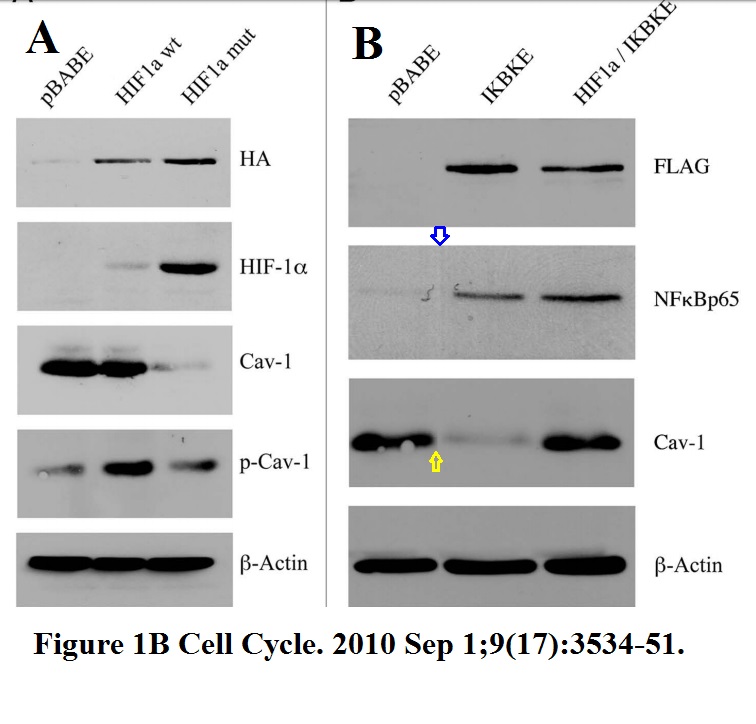
It may look like nothing serious, but there is a reason scientists must provide correct loading controls with their gels. In this case, the loading control is a “library” one. For some reason, the authors did not like what the empty vector pBABE samples delivered for NFkBp65 and Cav-1 results. A replacement lane was spliced on. Irregular gel splicing like this was actually never accepted or permitted. The evidence of data fakery in the next Lisanti paper however is more than clear:
FA. Medina , CJ. De Almeida , E Dew , J Li , G Bonuccelli , TM. Williams , AW. Cohen , RG. Pestell , PG. Frank , HB. Tanowitz , MP. Lisanti Caveolin-1-deficient mice show defects in innate immunity and inflammatory immune response during Salmonella enterica serovar Typhimurium infection Infection and Immunity (2006) doi: 10.1128/iai.00949-06
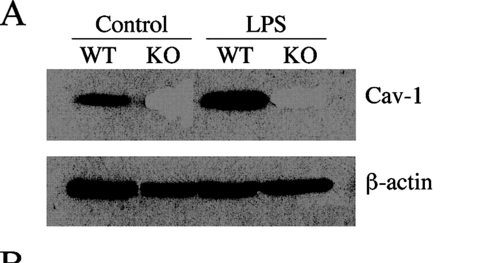
Do you see the two bands most obviously erased in Photoshop for “Cav-1 KO” samples? Now, as the paper’s title says, this is about Caveolin-1 deficient mice, obtained by genetically knocking-out (KO) a gene, here Cav-1. The KO mice were supposed to show no signal for Cav-1, but they apparently did very much, hence the Photoshop job. Does this change the conclusions of the paper that Cav-1 KO mice were actually not gene deficient at all? The journal, published by American Society for Microbiology (ASM), thinks it doesn’t. The paper was not just not retracted, nothing at all happened despite the now 6 year old public evidence.
Lisanti’s expertise, when he is not curing cancer and COVID-19 with antibiotics, is in the endocytosis and the relevant membrane protein caveolin, and this again is how he achieves the results:
Babak Razani, Michael P. Lisanti Two distinct caveolin-1 domains mediate the functional interaction of caveolin-1 with protein kinase A AJP Cell Physiology (2001) doi: 10.1152/ajpcell.2001.281.4.c1241
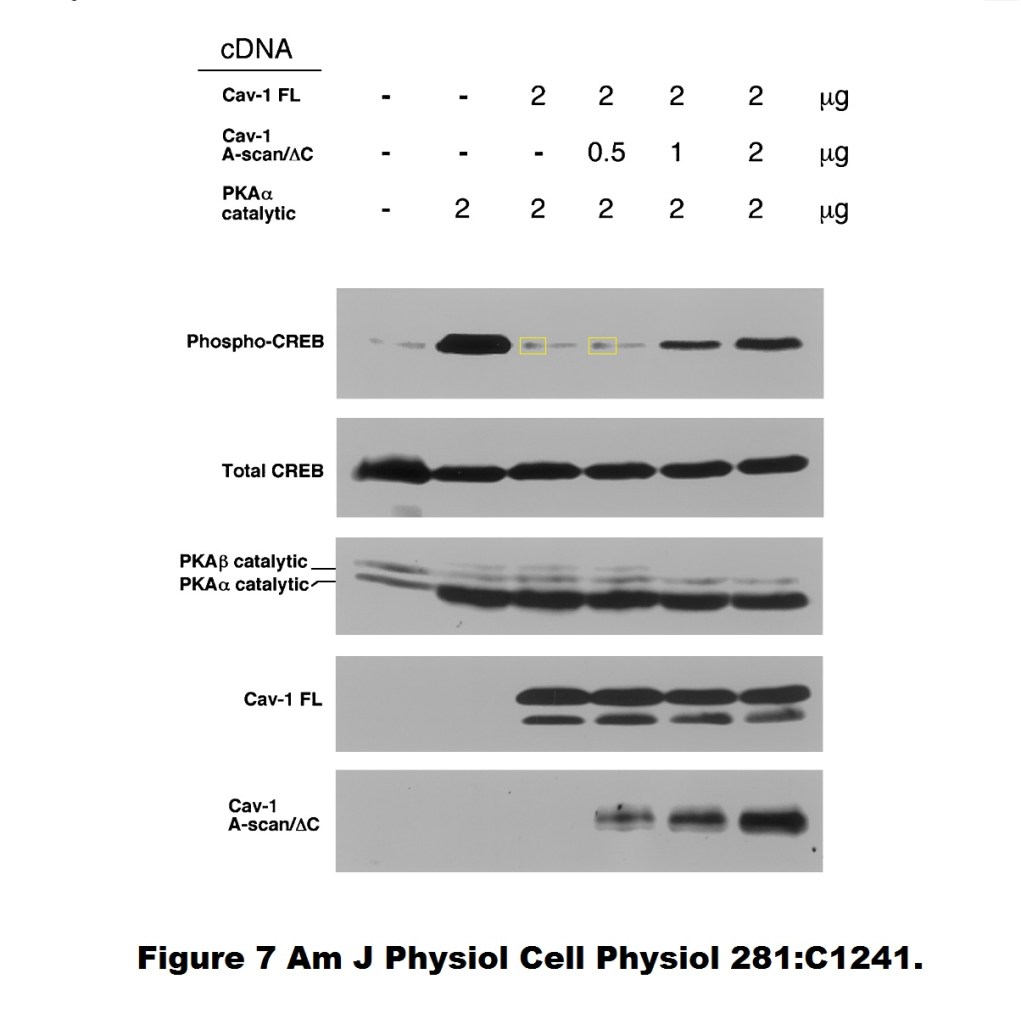
The two Phospho-CREB bands appear suspiciously similar. But the publisher American Physiological Society saw no reason to have a closer look. Noteworthy, this paper has only two authors, difficult to shift the blame to Lisanti’s collaborators at Albert Einstein College of Medicine, Richard Pestell , and definitely not upon Herbert Tanowitz , now deceased.
More of that, maybe?
Jasmin JF, Mercier I, Hnasko R, Cheung MW, Tanowitz HB, Dupuis J, Lisanti MP. Lung remodeling and pulmonary hypertension after myocardial infarction: pathogenic role of reduced caveolin expression. Cardiovasc Res. 2004 DOI: 10.1016/j.cardiores.2004.05.018
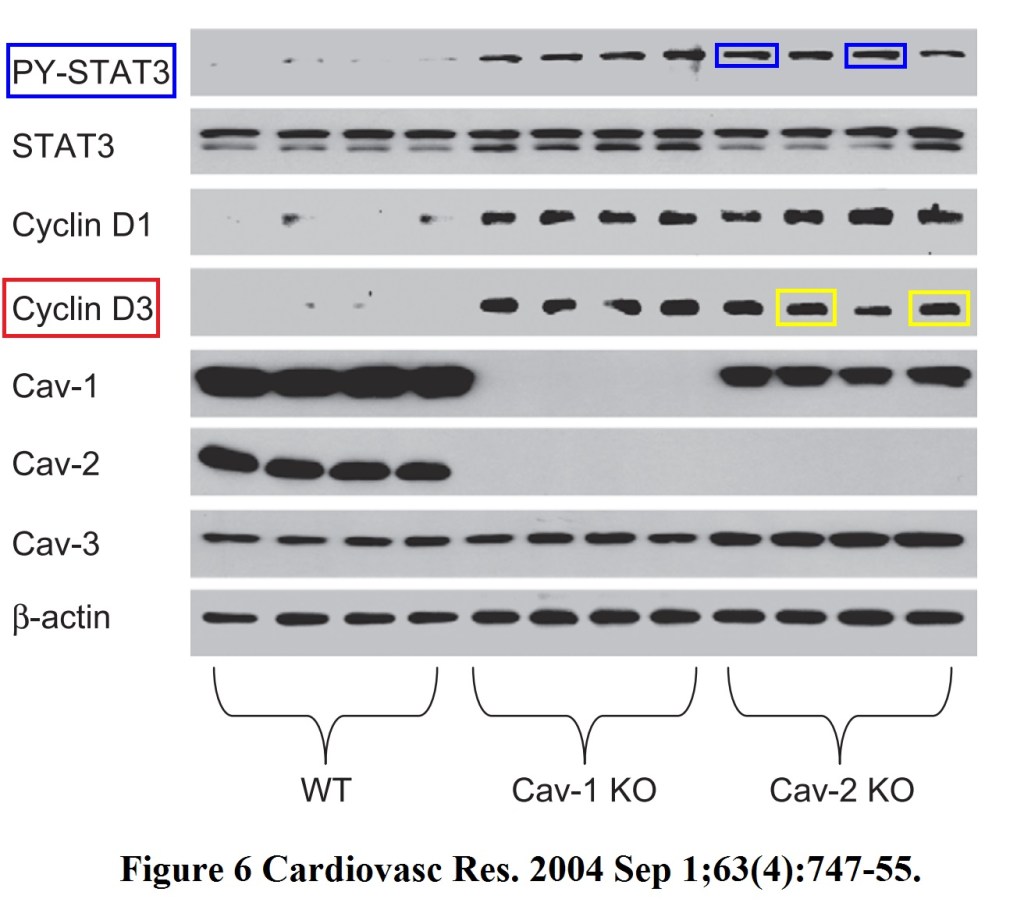
Just some copy-pasted gels bands apparently, quality science made at Einstein Medicine in New York.
Update 18.06.2020. Guess what the Editorial Office of Cardiovascular Research decided in this case:
“We have asked two independent reviewers to conduct in-depth image analysis and they have concluded that there is no evidence of data tampering. This was also reviewed by the ESC Journal Family Ethics Committee who agree with their findings. We have deemed that no correction is needed.“
Lisanti once did earn a retraction, but for a different paper, Schlegel & Lisanti J Cell Physiology 2001. The retraction notice went:
“The Publisher regrets that this review article must be withdrawn owing to an issue of multiple publication. The manuscript was submitted in nearly identical form to three journals (Frontiers in Bioscience, Cytokine and Growth Factor Reviews and Journal of Cellular Physiology) and was accepted and published by all three. As the article was accepted and published in Frontiers in Bioscience first, the copyright belongs to that journal.”
Seriously, what kind of lab does Lisanti run, where things like that happen? Finally, a vintage Lisanti, and there is more on PubPeer.

F. Galbiati , D Volonte , J A Engelman , G Watanabe , R Burk , R G Pestell, M P Lisanti Targeted downregulation of caveolin-1 is sufficient to drive cell transformation and hyperactivate the p42/44 MAP kinase cascade The EMBO Journal (1998) doi: 10.1093/emboj/17.22.6633
Whatever that is, it is not science. It is trolling, and it doesn’t matter that it happened long before the word was invented.
Media-savvy scientists like Lisanti, Guarente and Sinclair, and of course also Didier Raoult, are celebrated in the newspapers and on TV almost on weekly basis, each crazy claim of theirs makes national and international news because the solutions they offer are so simple, straightforward and magical. Nobody cares about how they actually do their science. Data manipulations? Pah. Debunked and irreproducible? Ignore their envious detractors.
Spanish government and science elites seem to feel they need to out-fraud the Americans and the French. The first ever COVID-19 research grant from the Ministry of Science and Innovation was awarded to… no seriously, it is not a joke: Carlos Lopez-Otin. A zombie scientist who even admitted data forgery, with 9 retractions and revoked Nature award, killer of over 5000 rodent witnesses, and a laughing stock of the entire scientific community outside of Spain. Incidentally, the national martyr St Carlos of Oviedo is also an anti-aging researcher, and yes, this is also what his COVID-19 approach will be about.
Now we are supposed to follow these alpha men’s (they are all men, incidentally) guidance on COVID-19 therapies. The journalists are convinced, the patients believe what scientists tell them in newspapers and run for bullshit cures. For proper, scientifically supported clinical trials, there is hardly anyone left to participate, and how does one do drug discovery for COVID-19 then?
Oh who cares, here is the sodding Robert Gallo himself with solutions to coronavirus vaccine and COVID-19. On BBC.

Donate!
If you are interested to support my work, you can leave here a small tip of $5. Or several of small tips, just increase the amount as you like (2x=€10; 5x=€25). Your generous patronage of my journalism will be most appreciated!
€5.00


“Which brings us to the next anti-aging expert and magic COVID-19 healer, Michael Lisanti, editorial board member of Aging and presently at the University of Manchester in UK.”
Not so.
https://www.salford.ac.uk/environment-life-sciences/our-staff/els-academics/michael-lisanti
“In Manchester, I previously held the Muriel Edith Rickman Chair of Breast Oncology.”
LikeLike
https://www.manchester.ac.uk/discover/news/article/?id=4757
“As the first incumbent of the Muriel Edith Rickman Chair in Breast Oncology, Professor Tony Howell brings world recognised expertise as both a researcher and clinician, and will lead an extended programme of research into breast cancer, and further develop national and international research collaborations.”
Muriel Edith Rickman Chair in Breast Oncology is held at University of Manchester, but Michael Lisanti is no longer at the University of Manchester.
LikeLike
Thanks, i corrected the article now!
LikeLike
An unsung contribution by Michael Lisanti is to the understanding of the parasite Trypanosoma cruzi.
A shining example to start with.
Infect Immun. 2004 Sep;72(9):5274-82.
Trypanosoma cruzi infection activates extracellular signal-regulated kinase in cultured endothelial and smooth muscle cells.
Mukherjee S1, Huang H, Petkova SB, Albanese C, Pestell RG, Braunstein VL, Christ GJ, Wittner M, Lisanti MP, Berman JW, Weiss LM, Tanowitz HB.
Author information
1
Department of Pathology, Albert Einstein College of Medicine, 1300 Morris Park Ave., Bronx, NY 10461, USA.
https://pubpeer.com/publications/5723E04D6F7CA792D1BDCF773AF185
Figure 1.
LikeLiked by 1 person
MP Lisanti contribution to the parasite Trypanosoma cruzi.
J Biol Chem. 2005 Jun 24;280(25):24085-94. Epub 2005 Apr 18.
The adipocyte as an important target cell for Trypanosoma cruzi infection.
Combs TP1, Nagajyothi, Mukherjee S, de Almeida CJ, Jelicks LA, Schubert W, Lin Y, Jayabalan DS, Zhao D, Braunstein VL, Landskroner-Eiger S, Cordero A, Factor SM, Weiss LM, Lisanti MP, Tanowitz HB, Scherer PE.
Author information
1
Department of Cell Biology, Albert Einstein College of Medicine, Bronx, New York 10461, USA.
https://pubpeer.com/publications/D58617DA508957B75D575347487433
Figure 4C.
LikeLiked by 1 person
MP Lisanti contribution to the parasite Trypanosoma cruzi.
Infect Immun. 2006 Jan;74(1):152-9.
Trypanosoma cruzi infection induces proliferation of vascular smooth muscle cells.
Hassan GS1, Mukherjee S, Nagajyothi F, Weiss LM, Petkova SB, de Almeida CJ, Huang H, Desruisseaux MS, Bouzahzah B, Pestell RG, Albanese C, Christ GJ, Lisanti MP, Tanowitz HB.
Author information
1
Department of Pathology, Albert Einstein College of Medicine, 1300 Morris Park Avenue, Bronx, NY 10461, USA.
https://pubpeer.com/publications/FBC5B4DE0B8F8A0969D96AE87E38E2
Figure 7.
LikeLiked by 1 person
MP Lisanti contribution to the parasite Trypanosoma cruzi.
N.B. “Chagasic” in the title is an adjective formed from Chagas [disease]
https://www.cdc.gov/parasites/chagas/index.html
Chagas disease is named after the Brazilian physician Carlos Chagas, who discovered the disease in 1909. It is caused by the parasite Trypanosoma cruzi, which is transmitted to animals and people by insect vectors and is found only in the Americas (mainly, in rural areas of Latin America where poverty is widespread).
Cell Cycle. 2006 Jan;5(1):107-12. Epub 2006 Jan 28.
Cyclin and caveolin expression in an acute model of murine Chagasic myocarditis.
Nagajyothi F1, Desruisseaux M, Bouzahzah B, Weiss LM, Andrade Ddos S, Factor SM, Scherer PE, Albanese C, Lisanti MP, Tanowitz HB.
Author information
1
Department of Pathology, Albert Einstein College of Medicine, Bronx, New York 10461, USA.
https://pubpeer.com/publications/D9D3D3E4A1CE27F0B1448026580FD3
Figures 3A and 5B.
LikeLike
MP Lisanti contribution to the parasite Trypanosoma cruzi.
N.B. “Chagasic” in the title is an adjective formed from Chagas [disease]
https://www.cdc.gov/parasites/chagas/index.html
Chagas disease is named after the Brazilian physician Carlos Chagas, who discovered the disease in 1909. It is caused by the parasite Trypanosoma cruzi, which is transmitted to animals and people by insect vectors and is found only in the Americas (mainly, in rural areas of Latin America where poverty is widespread).
I am surprised that the Brazilian government does not honor the monumental work of Herbert Tanowitz, Michael Lisanti and Richard Pestell for their combined contributions to understanding Trypanosoma cruzi and their contributions to the poor.
Infect Immun. 2003 May;71(5):2859-67.
Activation of transcription factors AP-1 and NF-kappa B in murine Chagasic myocarditis.
Huang H1, Petkova SB, Cohen AW, Bouzahzah B, Chan J, Zhou JN, Factor SM, Weiss LM, Krishnamachary M, Mukherjee S, Wittner M, Kitsis RN, Pestell RG, Lisanti MP, Albanese C, Tanowitz HB.
Author information
1
Department of Pathology, Albert Einstein College of Medicine, Bronx, New York 10461, USA.
https://pubpeer.com/publications/AD7861E62EAB0AF2FEDA836795E352
Figure 2B.
LikeLike
https://www.einstein.yu.edu/departments/medicine/news/herbert-tanowitz-in-memoriam/
Now that the Albert Einstein College of Medicine is:
“Mourning the Loss of Dr. Herbert Tanowitz”
and describes him as,
“A world-class infectious diseases researcher, Dr. Tanowitz was dedicated to science and renowned for his pioneering work in the study of parasites and, in particular, for his work on the pathogenesis of Chagas Disease due to Trypanosoma cruzi infection. His laboratory investigated the pathogenesis of Chagasic heart disease and the consequences of Trypanosoma cruzi infection on the pathophysiology of the host. In recognition of his contributions, he was elected in 2009 to the Brazilian Academy of Sciences. When he visited Brazil to present his induction lecture, Dr. Tanowitz was treated as an academic rock star by the faculty and students, who wanted to meet the famous professor and author of many of the papers that are required reading for understanding this infection, Dr. Weiss recalled.”,
and notes that,
“in 2010, he received the Dominick P. Purpura Distinguished Alumnus Award and received the Walter Colli Award during the 27th annual meeting of the Brazilian Society of Protozoology, in 2011”,
surely the Albert Einstein College of Medicine could honor, and perhaps memorialize, Herbert Tanowitz (Brazilian scientific societies seem to have awarded him) appropriately?
Would it be going too far to call for one of the new buildings be named after him, one in his own field of pathology?
“The Hebert Tanowitz building of translational and pathological sciences” seems fitting.
The Albert Einstein College of Medicine is ahead of the curve having made notable contributions to pathological science within living memory:-
Perez-Soler. https://www.einstein.yu.edu/faculty/8581/roman-perez-soler/
https://retractionwatch.com/2015/09/16/fourth-retraction-for-einstein-oncologist-due-to-image-manipulations/
https://retractionwatch.com/2013/09/06/papers-on-potential-cancer-drugs-retracted-for-image-manipulation/
Sanjeev Gupta.https://www.einstein.yu.edu/faculty/8041/sanjeev-gupta/
https://retractionwatch.com/2016/05/04/stem-cell-researchers-fix-two-papers-following-pubpeer-comments/
Shining example.
https://pubpeer.com/publications/4ADB5C01C3961C23D5AB632E07FF05#16
Figure 3C.
Correction: https://stemcellres.biomedcentral.com/articles/10.1186/s13287-015-0176-0
Credit where credit is due.
LikeLike
My favorite thread that explains a little of how David Sinclair and Sirtis duped GSK to buy them. A lot of it is because the leadership at GSK ignored their own staff scientists that said that they should not buy the company, because resveratrol derivatives were snake oil:
https://blogs.sciencemag.org/pipeline/archives/2010/01/12/the_sirtris_compounds_worthless_really
My favorite paper on how Lenny Guarente just cant seem to get the facts down correctly in this research:
https://science.sciencemag.org/content/334/6060/news-summaries (look for aging genes).
I look forward to retiring and leaving this seedy business of scientific research. This kind of stuff pisses me off.
LikeLiked by 1 person
Jealous, eh?
LikeLike
I think its fair to say if Sinclair was truly interested in the scientific truth, instead of trying to become famous and rich by publishing compelling but shoddy work that turns out to be wrong, he would still be a post-doc (failed scientist), or a sheep herder in Australia.
LikeLike
Cardiovasc Res. 2004 Sep 1;63(4):747-55.Lung remodeling and pulmonary hypertension after myocardial infarction: pathogenic role of reduced caveolin expression.
Jasmin JF1, Mercier I, Hnasko R, Cheung MW, Tanowitz HB, Dupuis J, Lisanti MP.
Author information1Department of Molecular Pharmacology, Albert Einstein College of Medicine, 1300 Morris Park Avenue, Bronx, NY 10461, USA.
Figure 6. Much more similar than expected.
LikeLike
Patrick Vallance was one of the executives at GSK that allegedly ignored the advice of internal scientists and bought Sinclair’s company for $720 million. Although Sirtis’s drugs were abandoned by GSK, he became Sir Patrick Vallance FRS and was appointed Chief Scientific Adviser to the Government of the United Kingdom. He told Sky News, to fight Covid-19 “Communities will become immune to it and that’s going to be an important part of controlling this longer term,” he said. “About 60 per cent is the sort of figure you need to get herd immunity.”
LikeLike
Pingback: Grand Est - Ocasapiens - Blog - Repubblica.it
Microbes Infect. 2008 Jan;10(1):21-8. 10.1016/j.micinf.2007.09.017
Trypanosoma cruzi induces changes in cardiac connexin43 expression☆
lDanielAdesseaLuciana R.GarzoniabHuanHuangcHerbert B.TanowitzcMariade Nazareth MeirellesaDavid C.Sprayd a Laboratorio de Ultra-estrutura Celular, Instituto Oswaldo Cruz – Fiocruz, Rio de Janeiro, Brazil
b Laboratório de Farmacologia Neurocardiovascular, Instituto Oswaldo Cruz – Fiocruz, Rio de Janeiro, Brazil c Department of Pathology, Albert Einstein College of Medicine, Bronx, NY, USA
d Dominick P. Purpura Department of Neuroscience, Albert Einstein College of Medicine, 1300 Morris Park Avenue, Kennedy Center Room 840, Bronx, NY 10461, USA.
https://pubpeer.com/publications/B324E841B8E84E4E2FC352F970B93B
Figure 1.
LikeLike
Cell Cycle. 2006 Oct;5(20):2396-400. Epub 2006 Oct 16.
Cell cycle regulatory proteins in the liver in murine Trypanosoma cruzi infection.
Bouzahzah B1, Nagajyothi F, Desruisseaux MS, Krishnamachary M, Factor SM, Cohen AW, Lisanti MP, Petkova SB, Pestell RG, Wittner M, Mukherjee S, Weiss LM, Jelicks LA, Albanese C, Tanowitz HB.
Author information
1
Department of Pathology at Albert Einstein College of Medicine, Bronx, New York 10461, USA.
https://pubpeer.com/publications/1B2E1AF5338849BC389A05336D7643#2
Figure 3.
LikeLike
Parasitol Res. 2013 Apr;112(4):1417-25. doi: 10.1007/s00436-012-3271-5. Epub 2013 Feb 13.
Identification of a functional prostanoid-like receptor in the protozoan parasite, Trypanosoma cruzi.
Mukherjee S1, Sadekar N, Ashton AW, Huang H, Spray DC, Lisanti MP, Machado FS, Weiss LM, Tanowitz HB.
Author information
1
Department of Pathology, Albert Einstein College of Medicine, 1300 Morris Park Avenue, Bronx, NY, USA.
https://pubpeer.com/publications/DB6B2ED4E4FD870763A4BB0D36A6DC
Figure 1.
From https://www.ncbi.nlm.nih.gov/pmc/articles/PMC3600064/pdf/nihms445485.pdf
LikeLike
https://www.einstein.yu.edu/about/
“Mission
Albert Einstein College of Medicine is a research-intensive medical school. For more than 60 years, our diverse faculty and staff have set the standard for excellence in medical and graduate education and patient-centered clinical care, and have made major contributions to scientific research enhancing human health in our communities and beyond. Our mission is to prepare a diverse body of students to become knowledgeable, compassionate physicians and innovative scientific investigators, and to create new knowledge.”
From Leonid’s article.
“Based on advice from the US Office of Research Integrity, the allegations about Professor Lisanti were passed on to his former employers, Albert Einstein College of Medicine in New York City and Thomas Jefferson University in Philadelphia, from which Professor Lisanti moved to Manchester in 2010.
The Manchester spokeswoman said the latter had not upheld the allegations, while the former had decided not to pursue the matter. An Albert Einstein spokeswoman said this was because the work in question had been done more than seven years ago – beyond the period within which the ORI requires an in-depth investigation.
“Professor Lisanti left Einstein in 2006. [He has done] no research…at Einstein since that time so we did not pursue additional inquiries,” she added. Professor Lisanti did not respond to an invitation to comment.”
That’s O.K. then! Managerialism at its highest.
LikeLike
PLoS Pathog. 2007 Nov; 3(11): e185. https://www.ncbi.nlm.nih.gov/pmc/articles/PMC2098834/
Published online 2007 Nov 30. doi: 10.1371/journal.ppat.0030185
PMCID: PMC2098834
PMID: 18052532
Bradykinin B2 Receptors of Dendritic Cells, Acting as Sensors of Kinins Proteolytically Released by Trypanosoma cruzi, Are Critical for the Development of Protective Type-1 Responses
Ana Carolina Monteiro,1 Verônica Schmitz,1 Alexandre Morrot,2 Luciana Barros de Arruda,3 Fnu Nagajyothi,4 Alessandra Granato,1 João B Pesquero,5 Werner Müller-Esterl,6 Herbert B Tanowitz,4 and Julio Scharfstein1,*
Eleanor M Riley, Editor
Author information Article notes Copyright and License information Disclaimer
1 Instituto de Biofisica Carlos Chagas Filho, UFRJ, Rio de Janeiro, Brazil
2 Intracellular Parasite Biology Section Laboratory of Parasitic Diseases, National Institute of Allergy and Infectious Diseases, Bethesda, Maryland, United States of America
3 Instituto de Microbiologia Paulo de Goes, UFRJ, Rio de Janeiro, Brazil
4 Albert Einstein College of Medicine, Bronx, New York, United States of America
5 Departmento de Biofisica, USP, São Paulo, Brazil
6 Institute of Biochemistry II, University of Frankfurt Medical School, Frankfurt, Germany
London School of Hygiene and Tropical Medicine, United Kingdom
Figure 5. Much more similar than expected.
LikeLike
J Cell Sci. 2005 Mar 1;118(Pt 5):901-15. Epub 2005 Feb 15.Chagasin, the endogenous cysteine-protease inhibitor of Trypanosoma cruzi, modulates parasite differentiation and invasion of mammalian cells.Santos CC1, Sant’anna C, Terres A, Cunha-e-Silva NL, Scharfstein J, de A Lima AP.Author information1Instituto de Biofísica Carlos Chagas Filho, Universidade Federal do Rio de Janeiro, C.C.S., Ilha do Fundão, Rio de Janeiro, 21949-900 RJ, Brazil.
Figure 3A.
LikeLike
So… Are you saying NAD+ is not a cure for old age? Because I really want to stop aging and live forever in a world full of parasitic frauds who who are enabled by the highly educated intellectual elites whom our politicians (eager to spend our taxes) turn to for solutions (for a percentage of the grant money) to only the most important lige or death problems (not their life or death but ours of course).
LikeLike
“In 2008, Slaoui led the $720 million acquisition of Sirtris Pharmaceuticals, which folded in 2013.” Now this guy is heading the vaccine effort in the US. How do these ” failed/failure scientists” (literally) get to positions of power? Back scratching.
LikeLike
Slaoui is also head of Moderna with $10mn stock in that company. He resigned from the position to become Trump’s coronavirus vaccine tsar last week.
Then Moderna incidentally announced that for the first time ever, they designed a working vaccine, with positive phase 2 trial results against covid19:
https://edition.cnn.com/2020/05/18/health/coronavirus-vaccine-moderna-early-results/index.html
Moderna stock went up 20%
https://www.latimes.com/business/story/2020-05-18/moderna-coronavirus-vaccine-divestment
Read more about Moderna’s history:
https://www.statnews.com/2016/09/13/moderna-therapeutics-biotech-mrna/
https://forbetterscience.com/2017/03/20/the-kenneth-chien-case-at-karolinska-by-johan-thyberg/
NMH, I am sorry to say, your country is a parody of a banana republic.
LikeLike
You are a culturist, Leonid! Disgusting!
LikeLiked by 1 person
Maybe next we will see David Sinclair take a post in the Trump admin, working closely with —who else—Jared Kushner. spits.
LikeLike